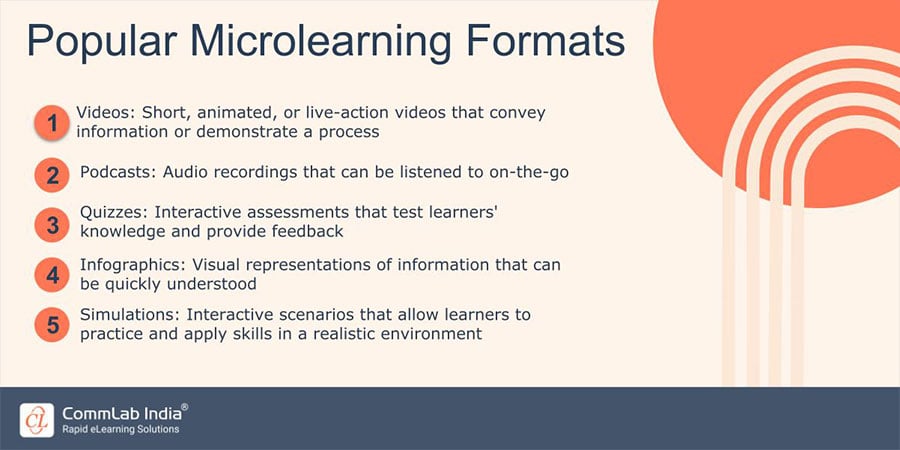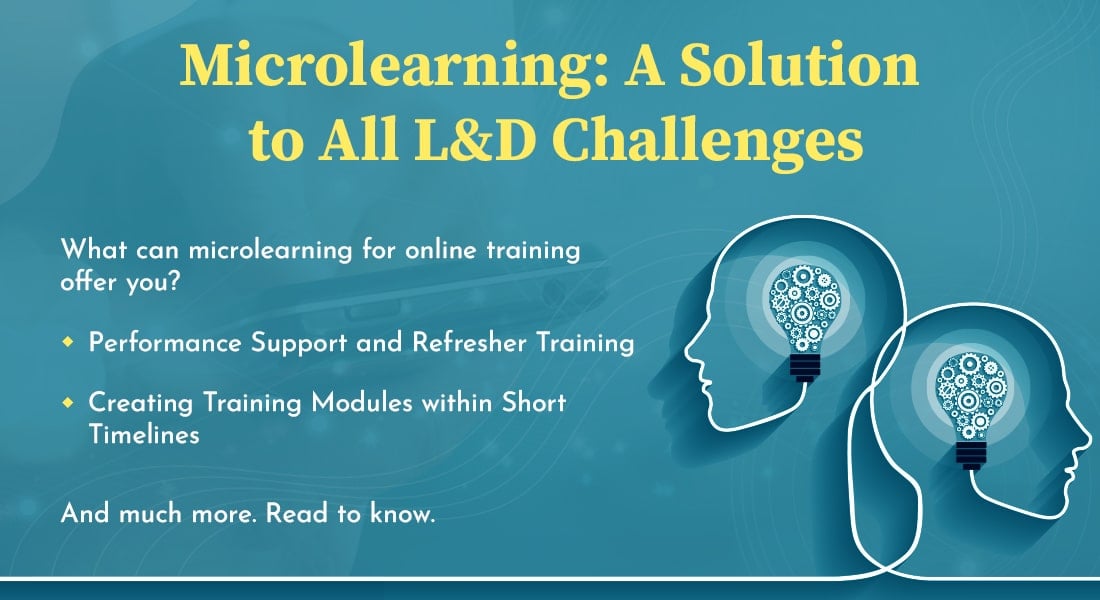7 Problematic Corporate Training Challenges Solved! Microlearning to The Rescue

Ah, corporate training! The mere mention of it often evokes images of never-ending PowerPoint presentations, monotone instructors, and employees desperately counting down the minutes until they can escape the clutches of yet another mind-numbing session. But, long gone are the days this was an everyday reality, all thanks to the various new-age learning strategies and techniques. Microlearning is one such method that helps modern learners stay engaged with their training sessions and solves a lot of challenges that traditional training methods possibly can’t. This blog lists 7 major challenges organizations can overcome, with the help of microlearning.
Wish to Overcome Various Corporate Training Challenges? Get Started with Microlearning!
Here are a few challenges it solves easily –
- Overcoming Information Overload
- Combating Short Attention Spans
- Retaining and Reinforcing Information
- Saving Time and Money
Read on to check out a few ways you can implement microlearning.
Picture this: bite-sized chunks of information, easily digestible, and delivered in a format that holds your attention without making you want to tear your hair out. This, in a nutshell, is what microlearning is all about. Microlearning has a lot of formats that add up to its excessive versatility, some of the popular formats are infographics, podcasts, videos, mini-games, quizzes, and eBooks. Here are the corporate training challenges it can overcome efficiently.
7 Corporate Training Challenges Microlearning Can Overcome
1. Overcoming Information Overload
One of the biggest challenges in corporate training is the overwhelming amount of information dumped on employees in a short period. Microlearning provides the perfect antidote by breaking down complex concepts into easily digestible modules. Imagine a series of short, engaging videos or interactive quizzes that keep employees engaged and entertained. It’s like having your favorite stand-up comedian explaining project management to you!

2. Combating Short Attention Spans
Let’s face it, our attention spans have been shrinking faster than a sweater in the dryer. Traditional training methods struggle to hold our focus for more than a few minutes. Microlearning, on the other hand, embraces this reality as it introduces an element of entertainment and humor, making the content more engaging and enjoyable. It incorporates interactive elements such as videos, quizzes, and gamification to keep employees actively participating. By delivering information in bite-sized pieces, it caters to our short attention spans while keeping us entertained.
→ Download eBook Now: Microlearning 101
3. Providing Flexibility and Accessibility
Gone are the days when everyone had to gather in a stuffy conference room at the same time for training. Microlearning offers a flexible solution by providing training modules that can be accessed at any time and from anywhere. Employees can access training modules at their own convenience, whether it’s on their smartphones during a coffee break or during a lunchtime escape to a cozy corner. Employees can even fit in learning during commutes or whenever they have a few spare minutes. The possibilities for mobile learning are endless, and the freedom to learn at one’s own pace is truly liberating.
4. Retaining and Reinforcing Information
Retaining and reinforcing knowledge over time is a common challenge in corporate training. Microlearning employs spaced repetition techniques, delivering information in small doses at regular intervals. This approach reinforces learning and improves long-term retention. Learning is an ongoing process, and traditional training sessions may not adequately support continuous learning. Microlearning fosters a culture of continuous learning by offering a library of modules on various topics. Employees can access these resources as needed, expanding their knowledge and skills at their own pace.
5. Saving Time and Money
Traditional training methods often come with high costs associated with instructors, venues, and printed materials. Microlearning offers a cost-effective alternative by utilizing digital platforms and resources. It reduces expenses while providing effective training solutions. As we have already discussed, microlearning modules are really short, they eventually take less time to get designed, saving time twice, i.e. once for developers, and then for learners. On top of that, even the efforts are minimized, while none of the quality aspects are compromised, making it one of the best modern-day training methods.
6. Nullifying Digital Literacy Gap
By leveraging microlearning, organizations can empower employees with the digital skills required for their roles, regardless of their initial level of digital literacy. Microlearning’s bite-sized and targeted approach allows employees to build their digital literacy incrementally, boosting their confidence and enabling them to engage with digital tools and platforms more effectively. Ultimately, this contributes to a more digitally literate workforce, capable of thriving in the modern workplace. Additionally, microlearning’s flexible nature makes it easily accessible to employees with varying levels of digital literacy.
7. Creating Individualized Learning Paths
Employees have different learning needs and preferences. Microlearning enables personalized learning paths, allowing employees to choose modules based on their specific requirements. This individualized approach ensures that each employee receives training that aligns with their skill gaps and interests. The simplicity of microlearning modules ensures that employees can focus on the content rather than struggling with the technology.

5 Creative Ways to Implement Microlearning for Corporate Training
1.Video Nuggets : Create short, engaging microlearning videos that deliver key information and concepts with a touch of humor. Inject a pinch of wit, sprinkle some visual effects, and voila! You have a recipe for training success.
Watch this short video to understand how you can create engaging microlearning videos!
2. Gamified Quizzes: Turn learning into a game by designing interactive quizzes with a humorous twist. Reward employees with virtual badges or funny GIFs for every milestone they achieve. Remember, laughter and learning go hand in hand!
3. Memes and GIFs Galore: Spice up microlearning modules with humorous memes and GIFs related to the training content. For example, a module on data security can include a GIF of a squirrel trying to protect its acorns from sneaky hackers. It’s a fun way to reinforce important concepts while giving employees a good chuckle.
4. Virtual Reality Adventures: Take microlearning to the next level by incorporating virtual reality (VR) experiences with a comedic twist. Employees can step into different work-related VR scenarios where they practice problem-solving or decision-making skills in a light-hearted and immersive environment. It’s an unforgettable way to learn while having a good laugh!
5. Comic Strip Storyboards: Transform training content into entertaining comic strip storyboards. Break down important concepts into sequential panels with humorous dialogue and visual gags. For instance, in a module about time management, share a funny story about someone trying to juggle multiple tasks with hilarious consequences. Not only does it make the content more engaging, but it also adds a touch of levity while reinforcing the key message.
Signing Out!
Microlearning is the superhero we’ve been waiting for in the world of corporate training. By tackling information overload, catering to short attention spans, and embracing flexibility, it brings a fresh and humorous approach to learning. Whether it’s through entertaining videos, gamified quizzes, or fostering a light-hearted community of learners, microlearning has the power to transform the way we acquire knowledge and skills. If you wish to understand where microlearning fits in your learning strategy, you can check out this amazing eBook and get all your doubts cleared.




![5 Practical Applications of Microlearning in Corporate Training [Infographic]](https://blog.commlabindia.com/hubfs/Imported_Blog_Media/5-Practical-Applications-of-Microlearning-in-Corporate-Training-Infographic.jpg)
![Why Should You Consider Microlearning for Sales Training [Infographic]](https://blog.commlabindia.com/hubfs/blogs/microlearning-sales-training-considerations-infographic.jpg)